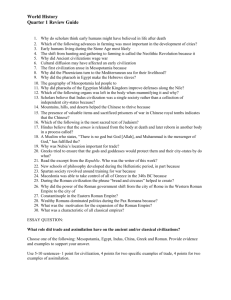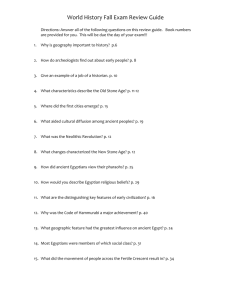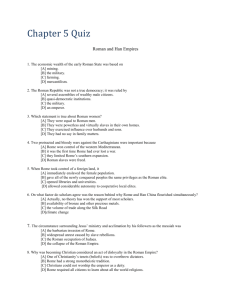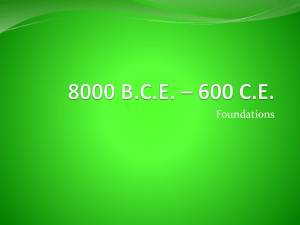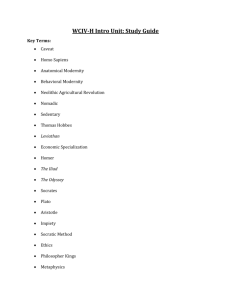Test Number: ____(Write this number on your scantron) Block: ___
advertisement
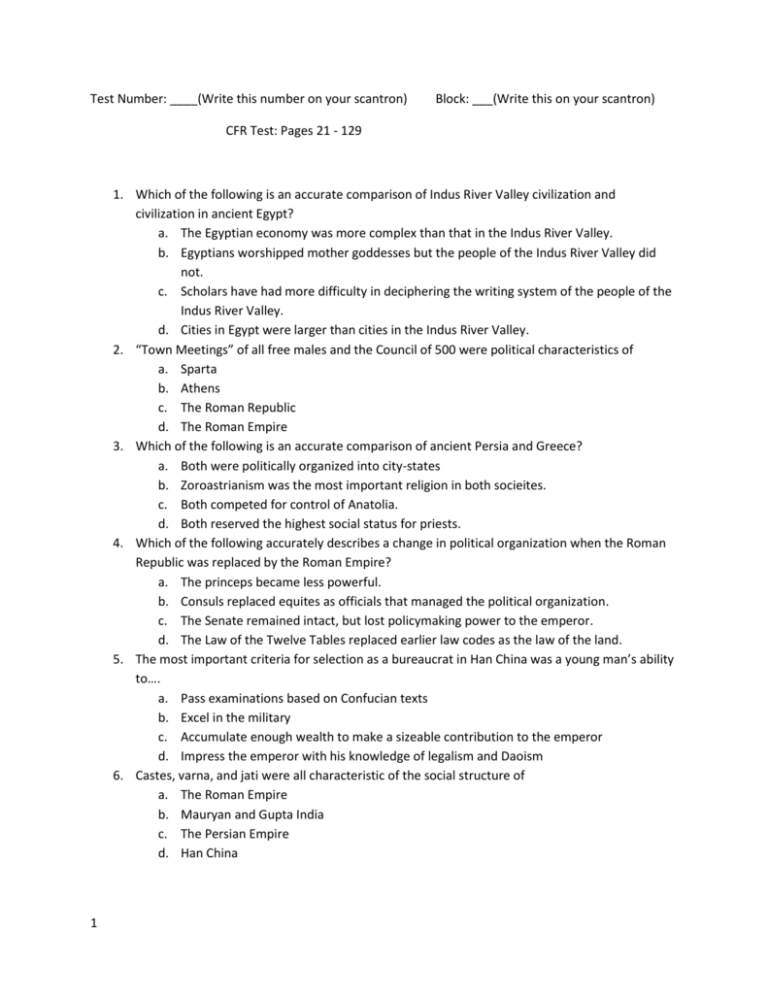
Test Number: ____(Write this number on your scantron) Block: ___(Write this on your scantron) CFR Test: Pages 21 - 129 1. Which of the following is an accurate comparison of Indus River Valley civilization and civilization in ancient Egypt? a. The Egyptian economy was more complex than that in the Indus River Valley. b. Egyptians worshipped mother goddesses but the people of the Indus River Valley did not. c. Scholars have had more difficulty in deciphering the writing system of the people of the Indus River Valley. d. Cities in Egypt were larger than cities in the Indus River Valley. 2. “Town Meetings” of all free males and the Council of 500 were political characteristics of a. Sparta b. Athens c. The Roman Republic d. The Roman Empire 3. Which of the following is an accurate comparison of ancient Persia and Greece? a. Both were politically organized into city-states b. Zoroastrianism was the most important religion in both socieites. c. Both competed for control of Anatolia. d. Both reserved the highest social status for priests. 4. Which of the following accurately describes a change in political organization when the Roman Republic was replaced by the Roman Empire? a. The princeps became less powerful. b. Consuls replaced equites as officials that managed the political organization. c. The Senate remained intact, but lost policymaking power to the emperor. d. The Law of the Twelve Tables replaced earlier law codes as the law of the land. 5. The most important criteria for selection as a bureaucrat in Han China was a young man’s ability to…. a. Pass examinations based on Confucian texts b. Excel in the military c. Accumulate enough wealth to make a sizeable contribution to the emperor d. Impress the emperor with his knowledge of legalism and Daoism 6. Castes, varna, and jati were all characteristic of the social structure of a. The Roman Empire b. Mauryan and Gupta India c. The Persian Empire d. Han China 1 7. Shi Huangdi and Ashoka are notable leaders of their civilizations in that both a. Conquered regional leaders to organize their societies into empires b. Used legalism to organize their societies c. Commanded very strong popular support d. Created empires that survived their deaths and lasted for centuries 8. Which of the following areas was NOT directly involved in the Indian Ocean trade between 300 B.C.E. and 600 C.E? a. The Tarim Basin b. Coastal East Africa c. Lands along the Persian Gulf d. Southeast Asia 9. The belief that following one’s dharma attached to one’s karma will allow the believer to eventually attain moksha is central to a. Hinduism b. Confucianism c. Daoism d. Zoroastrianism 10. Confucianism constrast with most other early belief systems in its emphasis on the a. Human characteristics of gods b. Responsibilities of people in an orderly society c. Importance of following “right behavior in order to achieve eternal life d. “way” of nature as a force that is inevitable 11. Which of the following is an accurate statement about the writing system in Zhou China? a. The earliest form of Chinese writing was the pictograph b. Chinese writing contrasted with other early writing systems in that it included an alphabet. c. The Chinese writing system was less complex than other early writing systems. d. Chinese writing was closely associated with merchants and long-distance trade. 12. In contrast to the Olmec, the Chavin of South America a. Had few organized trading caravans b. Were centered on a river valley c. Had a domesticated beast of burden d. Did not have advanced metallurgical skills 13. An important difference between civilization in early China and early Mesoamerica is that in China a. Civilization centered on river valleys but civilization in Mesoamerica did not b. Social hierarchies were more authoritarian than in Mesoamerica c. Priests had more political power than in Mesoamerica d. The economy was more dependent on agriculture than in Mesoamerica 2 14. Which of the following civilizations was politically organized into city-states? a. Greece b. Rome c. Han China d. Persia 15. Which of the following pairs of ancient civilizations put the most emphasis on secularism (nonreligious government)? a. Greece and Gupta India b. Persia and Rome c. Maurya India and Rome d. Greece and Han China 16. Which of the Classical Empires did not maintain its’ identity after it fell a. China b. India c. Greece d. Rome 17. Politics in the Roman Republic were strongly shaped by a. Democratic principles b. Patron-client relations c. Religious principles d. The opinions of the emperor 18. Which of the following is NOT an accurate statement about the rule of Shi Huangdi? a. The first fortifications of the Great Wall were built b. Laws and currencies were standardized to apply across regional states. c. He mandated that one version of Chinese script be used all over the empire. d. He was one of the most popular leaders in Chinese history. 19. Which of the following had the highest social status in Han China? a. Priests b. Merchants c. Skilled artisans d. Scholar-gentry 20. The man who attacked the Roman Empire was Attila. His people were called a. Germanic b. Bantu c. Visigoths d. Huns 21. Both the Persian and Gupta Empires used which method to ensure the loyalty of their people a. Democracy b. Mutual Respect c. Theatre state d. Religion 3 22. The capital of the Persian Empire was a. Ankara b. Persepolis c. Athens d. Magadha 23. The ruler of the Mauryan Dynasty, Ashoka, was the grandson of a. Xerxes b. Pericles c. Chandragupta d. Siddhartha 24. The social divisions in Indian society were called a. Moksha b. Karma c. Jati d. Dharma 25. The period in Indian history from 1500 to 500 B.C. is called a. The Neolithic Revolution b. The Agricultural Revolution c. The Vedic Age d. The Golden Age 26. Which is the highest caste in the Indian social hierarchy a. Shudra b. Kshatriya c. Brahmins d. Vaishya 27. Which is not considered a main social class in Han China? a. The warrior class b. The ordinary but free citizens c. The scholar-gentry d. The underclass 28. Which Chinese dynasty created the “Mandate of Heaven”? a. Xi b. Shang c. Zhou d. Han 29. Which Chinese dynasty expanded enough to come into trade contact with Rome? a. Shang b. Zhou c. Qin d. Han 4 30. This Chinese philosophy emphasizes that humans are naturally evil and will only obey authority through force. a. Confucianism b. Zen Buddhism c. Daoism d. Legalism 31. The philosopher that developed the tenets of Daoism was a. Shi Huangdi b. Laozi c. Han Wudi d. Liu Bang 32. Which Roman Emperor established a second capital for the Roman Empire in the 4th Century C.E. a. Constantine b. Diocletian c. Caligula d. Augustus 33. Which Roman poet linked the great epic poetry of the Greeks to Roman history in his Aeneid? a. Livy b. Socrates c. Virgil d. Ovid 34. The Roman idea that service to the state and community is the highest calling is called a. Epicureanism b. Paganism c. Stoicism d. Veritas 35. The Punic Wars were fought between a. Athens and Persia b. Rome and Carthage c. Rome and Greece d. Rome and the Huns 36. The economic problems and weak emperors that followed the Pax Romana happened in which century C.E.? a. 1st b. 2nd c. 3rd d. 4th 5 37. According to traditional Chinese beliefs, a ruling dynasty lost its right to rule when it a. Lost the mandate of heaven b. Lost its confidence in shamans c. Experienced systems failure d. Failed to properly interpret oracle bones 38. Like most other early civilizations, the Olmec gave particularly high social status to a. Merchants b. Artisans c. Priests d. Sculptors and painters 39. The Triumvirate created in order to challenge the power of the Roman Senate was composed of all of the following men except …. a. Julius Caesar b. Mark Antony c. Crassus d. Pompey 40. The Roman aristocrats that passed their positions down to their sons were called… a. Senators b. Plebeians c. Patricians d. Consuls 41. The 90% of the Roman population that were commoners were called… a. Senators b. Plebeians c. Patricians d. Consuls 42. The period of time following the conquests of Alexander the Great is commonly referred to as the… a. Greek Renaissance b. Golden Age of Greece c. Hellenistic Age d. Delian Age 43. The first major battle and victory of the Greeks over the Persians was called the Battle of…. a. Thermopylae b. Sparta c. Marathon d. Gaugamela 44. The Peloponnesian War was fought between a. Persia and Greece b. Athens and Sparta c. Rome and Greece d. Athens and Corinth 6 45. Everything we know of the Greek philosopher Socrates comes from his students a. Aristotle b. Plato c. Demothenes d. Pericles 46. In the Persian empire government representatives or governors were called… a. Helots b. Plebians c. Satraps d. Equites 47. Which Classical culture contained the most freedom for women? a. Roman b. Persian c. Spartan d. Athenian 48. Greek farmer soldiers were called a. Helots b. Equites c. Hoplites d. Satrapes 49. Which classical culture was out-numbered ten to one by their own slaves? a. Qin China b. Athens Greece c. Spartan Greece d. Roman Republic 50. The first phonetic alphabet was created by which culture? a. Greeks b. Phoenicians c. Persians d. Egyptians 51. Which is not a form of government found in the Greek poleis? a. Republic b. Monarchy c. Oligarchy d. Democracy 52. Which civilization replaced the Minoan civilization on the island of Crete? a. Roman b. Phoenician c. Mycenaean d. Assyrian 7 53. The two rivers of the Fertile Crescent are a. Indus and Euphrates b. Yangtze and Tigris c. Tigris and Euphrates d. Indus and Ganges 54. Both the Olmec and Chavin cultures were unique in the ancient period because a. They both only had one domestic animal b. They both developed around river Valleys in the Americas c. Neither culture developed around a single river Valley d. They were both democratic societies 55. The Olmec cultures giant carved stone heads probably represented a. Olmec Gods b. Cultural hero’s found in their myths c. Political Leaders d. Famous figures in Olmec art and literature 56. The Olmec civilization was based on a. Trade b. Religion c. Agriculture d. Slavery 57. Which of the following IS NOT a reason China differed from other ancient civilizations? a. It’s strong emphasis on the importance of religion b. The supreme importance of the family c. The emphasis on this world d. The Emphasis on learning and literacy 58. Which of the following IS NOT one of the three main social classes of Zhou, China? a. Unskilled Workers and slaves b. The elite c. Peasants, free artisans, and craftsmen d. Merchants 59. Payment to the government in order to support the monarch and his court (usually in the form of produce) is called? a. Vassals b. Shi c. Tribute d. Peonage 60. The most ancient dynasty of China is called a. Han b. Zhou c. Shang d. Xia 8 61. The Yellow River in China is also known as the a. Xi River b. Huai River c. Huang He River d. Wei River 62. The ancient Indus River Civilization came to end due to a. Internal warfare b. Systems failure c. Disease d. Invasion 63. The Indus River Valley civilizations had two major cities, they were a. Kush and Meroe b. Mohenjo-Dara and Harrappa c. Tyre and Ur d. Akkad and Uruk 64. The Akkadian Empire of Mesopotamia was founded by a. Hammurabi b. Sargon c. Pericles d. Abraham 65. The language that is the precursor of both Hebrew and Arabic languages is a. Phoenician b. Aramaic c. Semitic d. Sumerian 66. The wedge shaped writing of Mesopotamia’s ancient cultures is called a. Hieroglyphics b. Cuneiform c. Petroglyphs d. Phonetic 67. The Great Flood Story of Sumerian culture is found in what early piece of literature a. The Bible b. The Iliad c. The Epic of Gilgamesh d. Hammurabi’s Law Codes 68. How many cataracts lay within the ancient Egyptian cultural zone a. 1 b. 2 c. 3 d. 4 9 69. Which time period in Egypt was subject to the invasion of the Hyksos? a. The Old Kingdom b. The Middle Kingdom c. The New Kingdom d. The Contemporary Kingdom 70. Who is your sworn enemy and the sworn enemy of both Mr. Jensen and Mr. Bredburg. This individual should always be shunned and never be allowed near our classrooms or trusted in any way because he is dangerous, violent, and prone to loud burping and the expelling of large amounts of natural gas? a. Cory Jensen b. Misty Moffit c. Angela Thompson d. Kevin Tucker 1. 2. 3. 4. 5. 6. 7. 8. 9. 10. 11. 12. 13. 14. 15. 16. 17. 18. 19. 20. 21. 22. 23. 24. 25. 26. 10 Answer Key C B C C A B A A A B A C A A D D B D D D C B C C C C 27. 28. 29. 30. 31. 32. 33. 34. 35. 36. 37. 38. 39. 40. 41. 42. 43. 44. 45. 46. 47. 48. 49. 50. 51. 52. A C D D B A C C B C A C B C B C C B D C C C C B A C 53. 54. 55. 56. 57. 58. 59. 60. 61. 62. 63. 64. 65. 66. 67. 68. 69. 70. C C C C A D C D C B B B C B C B B D
